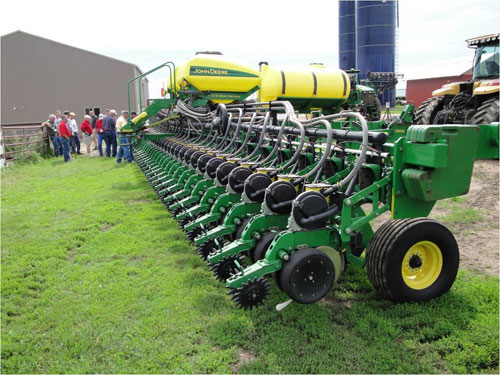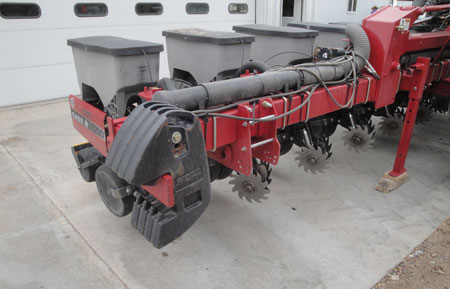Central Seed Hopper Planters May Need More Weight to Achieve Proper Seeding Depth



Some producers with the newer style, front-fold planters with a central seed hopper have been noticing problems with uniform seeding depth across the width of the planter. Some of these planters even have the new automatic downpressure control systems that are supposed to ensure the planter has enough downpressure on each row unit to properly place the seed at the set seeding depth. While the center section of the planter seems to be performing as set, producers are noticing progressively shallower seeding depths as they go out to the ends of the planter. This is especially a problem on planters ordered without markers where the producers are using RTK and autosteer to plant their fields.
While these large planters weigh a lot, especially fully loaded, it all comes down to a problem with the weight distribution across the width of the planter. Many of these front-fold planters have more than enough weight on the center section of the planter with the central seed hopper and often large fertilizer tanks on the hitch, but lack the needed weight on the wings. The downpressure system (even the manual adjust springs or airbag systems) may claim 400 or more pounds per row available downpressure, however, they may not be providing that on outside rows unless weights have been added to the ends of the planter.
The toolbar design allows the wings to float so that the planter can follow the ground contours across the width of the planter. As such, the weight on the center section isn't available for transferring to the row units on the wings (except for a few models from Kinze that have a toolbar weight transfer system or for some after-market weight transfer systems, but even they may need additional weight).
Producers should check downpressure and seeding depth when the planters are empty as that's the least amount of weight they will have in the field (see Preseason Field Check of Planting Equipment in the April 17 CropWatch). They also need to check all rows across the width of the planter as the weight isn't uniformly distributed across the toolbar. Downpressure systems on the row units on the wings near the pivot points of the toolbar will be able to transfer some of the center section weight to the row unit. However, several hundred pounds of weight usually has to be added to the outside ends of the wings on these large front-fold planters, especially on those without markers, to have sufficient weight for the downpressure systems to work properly on the outside row units.
The problem of non-uniform weight distribution also can occur on mounted planters with folding wings and on many stack-fold planters as these planters also flex across the width of the planter. Many of the newer versions of these planters have a central seed hopper that provides plenty of weight on the center section but they lack weight on the wings. Again, this problem is even worse on planters not equipped with markers. Weight usually needs to be added to the ends of these planters as well to achieve proper downpressure across the width of the planter to ensure proper planting depth.
Paul JasaExtension Engineer
Online Master of Science in Agronomy
With a focus on industry applications and research, the online program is designed with maximum flexibility for today's working professionals.
